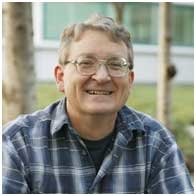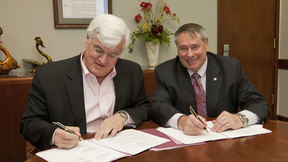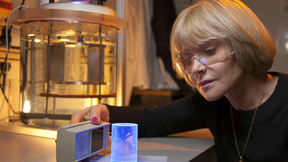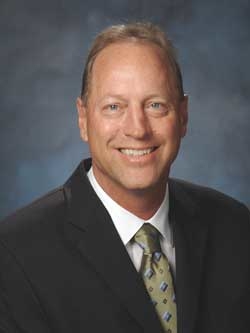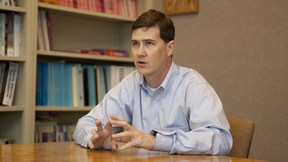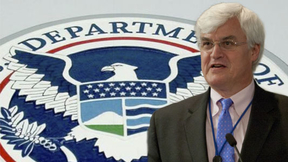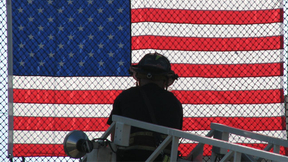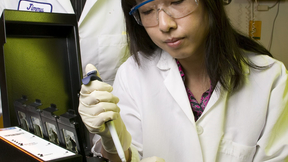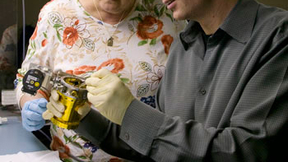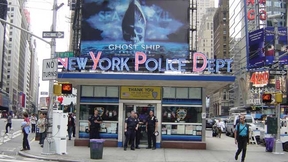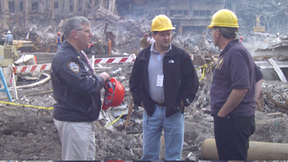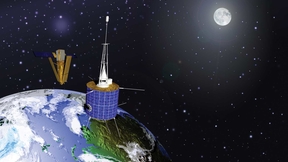Back
Global Security
Tom Slezak to advise Department of Defense on biodefense
Bioinformatics expert Tom Slezak is no stranger to the National Academy of Science (NAS), having served on two committees since 2009. Recently, he was asked to join a standing committee chartered by the Department of Defense (DoD) to advise the DoD on biodefense issues, a much broader scope than either of his previous committee mandates. The NAS in Washington, D.C., is the…
Lab to collaborate with NASA Ames Research Center
Lawrence Livermore National Laboratory (LLNL) and NASA's Ames Research Center (ARC) in Mountain View, Calif., have agreed to collaborate by sharing technology and resources on technical areas of national interest, including space missions, energy and advanced computing. LLNL director Parney Albright and ARC director Pete Worden signed the agreement Thursday in Livermore,…
Lawrence Livermore wins six R&D Awards for science, technological innovation
Lawrence Livermore National Laboratory researchers have won six awards for their efforts in developing breakthrough technologies with commercial potential. See video . R&D Magazine announced the winners of its annual R&D 100 Awards, sometimes called the "Oscars of Invention" on Wednesday. The awards will be presented Nov. 1 during a black-tie dinner at the SeaWorld…
Bruce E. Warner selected principal associate director, Global Security
Bruce Warner has been named principal associate director of Global Security at Lawrence Livermore National Laboratory, Director Parney Albright announced Thursday. Warner takes over the position from Albright, who stepped down as the Global Security leader after he was selected as the 11th Lab director last October. Warner had been serving in an acting capacity since…
Lawrence Livermore Laboratory team achieves breakthrough detecting nuclear materials
When a young man was advised to pursue a career in plastics in the 1967 movie, "The Graduate," people could not have envisioned one of the material's uses developed by Lawrence Livermore National Laboratory (LLNL) scientists. In a key discovery, a team of LLNL researchers has developed the first plastic material capable of efficiently distinguishing neutrons from gamma…
Hart returns to head Forensic Science Center
A former researcher in the Lab's Forensic Science Center (FSC) has returned to the Laboratory to lead the center. Brad Hart, who worked as a staff scientist at the FSC from 2004 to 2009, has been named the center's director and started his new position in early October. He returns to LLNL after working for more than two years at the Washington, D.C.-based Defense…
Advance by Lawrence Livermore scientists makes possible near-instantaneous DNA analysis
Picture this: You've brought your sick child to the doctor's office. After checking her pulse and blood pressure, he takes a nasal or throat swab and inserts it into a mysterious black box. Before the doctor finishes his examination, the black box beeps, indicating that the pathogen that's making your child sick has been identified. Sound far-fetched? Actually, this…
Success of DHS was built on relationship with Lab
Editor's note; The following is part of an ongoing series looking back at the events surrounding 9/11. Today's feature looks at the role the Laboratory played in establishing the Department of Homeland Security. On the morning of Sept. 11, 2001, Parney Albright already had spent 16 years working in national security. That morning, on a military base just outside Washington…
An underwater adventure
Many of Bruce Warner's most vivid memories revolve around water. Some of his first recollections as a toddler are of clinging to the side of a pool, ready for swimming lessons with his twin brother, Allen. Those early lessons set the foundation for a lifetime of comfort in water, one that has come far from that dark, damp Philadelphia pool. Warner, the Lab's associate…
Remembering September 11
What has become a solemn Lab tradition, a brief yet poignant ceremony was held Monday near the Superblock to commemorate the lives lost on Sept. 11, 2001 in New York City, the Pentagon, Washington D.C. and Pennsylvania. "Please pray for those who carry on without their loved ones," Chris Holm of the Superblock said during the program's introduction. Lab employee Jennifer…
Lab technologies answer nation's call to prevent bioterrorism
Editor's note -- This is the final article in a series on the Lab's response to the 9/11 attacks. Today's feature looks at the Lab's role in protecting the nation against bioterorrism. In trying to protect the nation against bioterrorism, national lab and university scientists, public health authorities and law enforcement agencies have waged the fight on many fronts…
Lab detects need for new radiation technologies
Editor's note: As the 10th anniversary of 9/11 approaches, Newsline is running a series of articles on the Lab's response to events following the attacks. Today's story looks at the Lab's contributions to radiation detection. September 11, 2001 served as a turning point for the United States. The first major attack on U.S. soil in nearly 60 years and the largest loss of…
Lab's work provides BASIS for biodetection
Editor's note: This is the second in a series of stories looking back at the Lab's response to events following Sept. 11. Today's piece focuses on the Lab's role in establishing BASIS - the Biological Aerosol Sentry and Information System - and BioWatch. By Stephen Wampler Telephone calls awakened Tom Slezak, Kris Montgomery and Cheryl Strout and Julie Avila at their homes…
Lab continues to answer the call for security
Editor's note: This is the first in a series of articles looking back at the Lab's response immediately following the Sept. 11 attacks and the Lab's response since that day 10 years ago. Today's article is adapted from a column by Wayne Shotts, the former head of the Nonproliferation, Arms Control and International Security Directorate (the predecessor organization to the…
LLNL partners with airports and DHS to keep planes flying
LLNL's ongoing collaborative work to address technical remediation challenges in returning critical transportation facilities to service following release of a chemical weapon agent (CWA) or toxic industrial chemical (TIC) recently culminated in a workshop for Midwest airports at the Colorado Convention Center in Denver. The workshop, called the CWA/TIC Remediation and…
Preventing close encounters of the orbiting kind
Each day, hundreds of active satellites as well as tens of thousands of pieces of "space junk" -- defunct satellites, bits of booster rockets and lost astronaut tools -- orbit Earth.This space junk became front page news two years ago, when a defunct Russian satellite and a privately owned American communications satellite collided near the North Pole. The incident…


